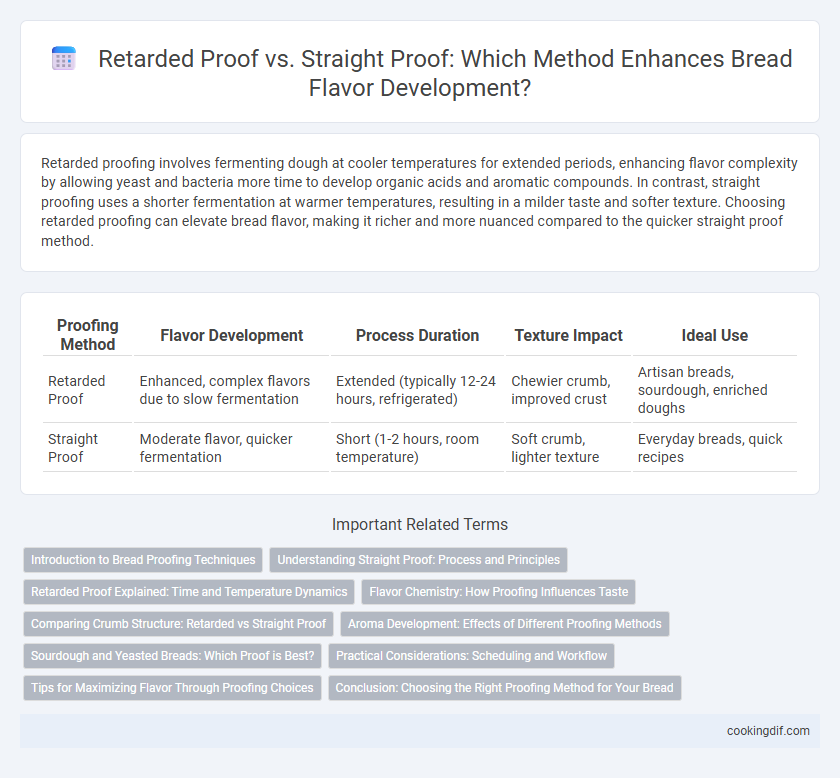Retarded proofing involves fermenting dough at cooler temperatures for extended periods, enhancing flavor complexity by allowing yeast and bacteria more time to develop organic acids and aromatic compounds. In contrast, straight proofing uses a shorter fermentation at warmer temperatures, resulting in a milder taste and softer texture. Choosing retarded proofing can elevate bread flavor, making it richer and more nuanced compared to the quicker straight proof method.
Table of Comparison
| Proofing Method | Flavor Development | Process Duration | Texture Impact | Ideal Use |
|---|---|---|---|---|
| Retarded Proof | Enhanced, complex flavors due to slow fermentation | Extended (typically 12-24 hours, refrigerated) | Chewier crumb, improved crust | Artisan breads, sourdough, enriched doughs |
| Straight Proof | Moderate flavor, quicker fermentation | Short (1-2 hours, room temperature) | Soft crumb, lighter texture | Everyday breads, quick recipes |
Introduction to Bread Proofing Techniques
Retarded proofing involves slow fermentation at low temperatures, enhancing complex flavor profiles by allowing yeast and enzymes to develop slowly over extended periods. Straight proofing accelerates fermentation at warmer temperatures, resulting in quicker rise times but milder flavor development compared to retarded proofing. Choosing between retarded and straight proof methods directly impacts bread aroma, texture, and overall taste intensity during proofing techniques.
Understanding Straight Proof: Process and Principles
Straight proof in bread making refers to a method where all ingredients, including yeast, flour, water, and salt, are mixed together and fermented in one step, promoting rapid flavor development through continuous fermentation. This process enhances enzymatic activity and yeast performance, resulting in a well-developed crumb texture and balanced taste without the complexity of extended retardation. Understanding straight proof is crucial for bakers aiming to achieve consistent bread quality with a simplified workflow that maximizes yeast fermentation efficiency.
Retarded Proof Explained: Time and Temperature Dynamics
Retarded proof involves fermenting dough at lower temperatures, typically between 35degF and 45degF, over extended periods ranging from 12 to 72 hours, which slows yeast activity and enhances complex flavor development through prolonged enzymatic reactions. This method promotes organic acid and alcohol formation, enriching the bread's aroma and tang while improving its crust color and crumb structure compared to traditional straight proofing. Temperature control during retarded proofing is crucial, as it balances yeast fermentation and enzymatic activity to maximize flavor without overproofing.
Flavor Chemistry: How Proofing Influences Taste
Retarded proofing, involving slow fermentation at lower temperatures, enhances flavor complexity by allowing yeast and enzymes more time to break down starches and proteins, producing a wider range of aromatic compounds such as organic acids and alcohols. Straight proofing, characterized by a shorter, warmer rise, results in a milder flavor profile with predominant yeast esters and less acidic development. The biochemical processes during retarded proofing amplify Maillard reactions and fermentation byproducts, yielding richer, tangier, and more nuanced bread flavors driven by advanced flavor chemistry.
Comparing Crumb Structure: Retarded vs Straight Proof
Retarded proofing, involving slow fermentation at low temperatures, enhances crumb structure by creating a more open, airy texture with irregular holes and improved moisture retention. Straight proofing, a faster fermentation at room temperature, typically results in a tighter crumb and denser texture due to rapid yeast activity. Comparing crumb structures, retarded proofed bread showcases superior flavor depth and a lighter, more delicate crumb, while straight proofed bread maintains firmness but lacks the same nuanced texture complexity.
Aroma Development: Effects of Different Proofing Methods
Retarded proof enhances aroma development by slowing fermentation, allowing complex flavor compounds and organic acids to form, which intensifies the bread's fragrance. Straight proofing accelerates yeast activity, producing a milder aroma and simpler flavor profile due to less time for ester and aldehyde formation. Retarded proofing also promotes increased maltose breakdown, contributing to richer, more pronounced crust aromas compared to straight proof methods.
Sourdough and Yeasted Breads: Which Proof is Best?
Retarded proof involves slowing fermentation by refrigerating dough, enhancing sourdough's complex flavors and developing nuanced acidity and depth. Straight proofing, a faster room-temperature fermentation, is typically favored for yeasted breads, producing lighter textures and milder taste profiles. For sourdough, retarded proof is best for maximizing flavor, while straight proof suits yeasted breads prioritizing softness and rise.
Practical Considerations: Scheduling and Workflow
Retarded proofing extends fermentation time by refrigerating dough, enhancing flavor complexity but requires precise scheduling to prevent workflow bottlenecks in commercial bakeries. Straight proofing shortens production cycles, favoring faster turnaround and simplifying scheduling, though it may compromise depth of flavor development. Balancing retarded and straight proof methods depends on bakery capacity, peak demand periods, and staff expertise to optimize both flavor and operational efficiency.
Tips for Maximizing Flavor Through Proofing Choices
Retarded proofing, which involves a slow fermentation in the refrigerator, enhances flavor complexity by allowing enzymes and yeast to develop organic acids and aromatic compounds over time. Straight proofing, conducted at room temperature for a shorter period, produces a milder flavor and a softer crumb, ideal for breads requiring a tender texture. To maximize flavor, bakers can combine both methods by starting with a retarded bulk fermentation to build depth, then finishing with a straight proof to achieve desired volume and crumb structure.
Conclusion: Choosing the Right Proofing Method for Your Bread
Retarded proofing enhances flavor depth by allowing slow fermentation in cold temperatures, promoting complex organic acids and yeast activity, while straight proofing offers faster results with a more straightforward taste profile. Bakers seeking rich, nuanced flavors typically prefer retarded proofing despite longer times, whereas straight proofing suits quick production with consistent texture. Selecting the proofing method depends on balancing desired flavor complexity, time constraints, and bread type for optimal results.
Retarded Proof vs Straight Proof for flavor development Infographic

 cookingdif.com
cookingdif.com